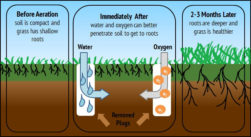Why Aerate?
Core aeration relieves soil compaction and allows the lawn to breathe.
Core aeration is the mechanical means of removing small plugs of thatch and soil from a lawn to allow the exchange of air between soil and the atmosphere. This process is recommended for most home lawns to:
- Relieve soil compaction
- “Knit” soil interfaces
- Reduce excessive thatch layers

Many turf grass areas suffer from soil compaction due to rainfall and foot or vehicular traffic. Although compaction is most often associated with athletic fields, home lawns can also suffer from compacted soil layers. Reasons for lawn compaction include construction activity prior to lawn establishment and traffic on high clay content soils, especially when wet.
Soil Compaction
Compaction causes individual soil particles to press together tightly. This decreases the pore space where air and water are held. A compacted layer of soil forms a physical barrier that limits infiltration of water in the soil and availability of soil oxygen. Aeration will improve the penetration of air and water into the soil, which encourages deeper root growth and better turf quality.
Soil Interface
Aeration is also useful where a soil interface exists. Soil interfaces form when one soil type overlays anther distinctly different soil type; in many instances, the sod used to establish a lawn is grown on soil that is organic in nature and distinctly different from the soil over which it is placed. The interface that develops between these two soil layers resists uniform movement of water, air and nutrients, resulting in irregular turf response. Aeration breaks up the interface and promotes better conditions for turf grass growth and development.
Excessive thatch layers
Another benefit of aeration is the modification of excess thatch layers. Thatch is a layer of dead and living stems and roots of grass that accumulates between the green grass blades and the soil surface. Multiple aerations that leave the cores on the lawn surface to break down will incorporate native soil into the thatch layer, thereby improving the water and nutrient holding capacities of the thatch. Microorganisms in the soil cores also help to decompose the thatch. Aeration is particularly useful on large turf areas where dethatching is impractical.
Annual Core Aeration
Annual core aeration is beneficial for most lawns. However, lawns with heavy clay soil or lawns exposed to intense use may need multiple aerations per year. Core aeration should be utilized during the most active root growth for the particular grass species. Spring and fall are ideal times to aerate most lawns.
